Harvia Spirit is the latest electric heater from the heater factory of Muurame (Finland). It falls into an interesting category of decorative "design" heaters . In the Saunologia’s test, the heater received a lot of positive feedback, especially for its short heating time. Spirit is a competitive, modern heater option from Finland ready to face increasing international competition.
Update 3rd Feb 2024:
The Spirit heater has been released in North America! Heater is available in 6 kW and 8 kW varieties. New WiFi-enable controller CX004 is the recommended power unit. Due to UL 875 compliance requirements, the North American model has few differences to the EU model described in this article. The differences are:
- Maximum powered on time: 1 h
- Maximum temperature: 194 F
- The top of the heater is covered by additional mesh
- Supports 240 VAC 1ph and 208 VAC 3ph
- Heating time is even faster than with the European models
In 2023 at Saunologia I am pushing the boundaries of sauna journalism, as I am publishing several sauna heater tests. In the past, heater reviews have been sporadic, but now I decided to give “löyly engines” a chance to step into the Saunologia’s spotlight.
I have never before been convinced that testing heaters in a laboratory, or even outside a laboratory, is a feasible idea. After all, following the longstanding test traditions of Finnish technical magazines, it’s clear that the differences between electric heaters in the same category are often minimal and that testing of wood-burning heaters must consider the wide range of emissions and efficiency. To properly study the burning process, complicated laboratory equipment are needed, putting this study economically beyond the reach of consumer research.
On the other hand, laboratories usually don't match anyone's actual sauna conditions, so now that I have a "real" example of a sauna in a common size range of less than 10 m³ (107 cu.ft.), I decided to give it a try. By standardizing other factors as much as possible and testing different heaters in the same sauna, I believe there should be plenty that can be learned from the experiment.
So now I have the pleasure and honour to present the first ever heater test coming from my sauna, powered by Harvia Spirit of Löyly!
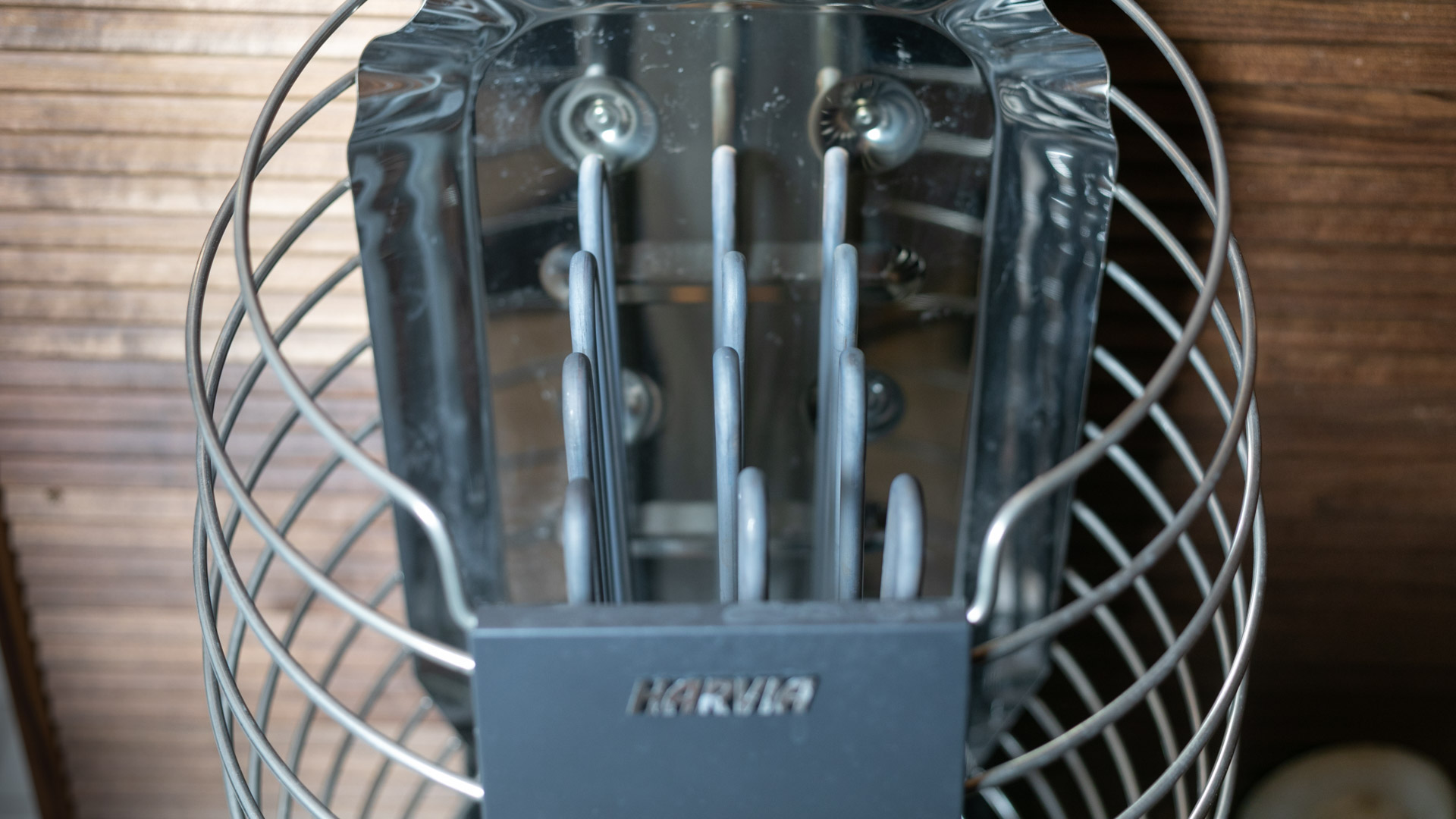
What is Harvia Spirit?
At the end of 2022, Harvia launched the new Spirit electric heater. The new wall-mounted heater is intended for small- and medium-sized saunas (5-14 m³). It’s available in both 6 and 9 kW power ratings and can be controlled both by a standard external control panel and by remotely using a mobile app. For this reason, four versions of the heater are available. The remote-operated models are identified by the XW-ending following the model number. They come with a heater control unit that can be installed inside the sauna. The SP90XW that I tested here, for example, is one of these. For the E model, you can choose the compatible external control unit of your choice.
Product Group Manager Arto Harvia recounts the development of Spirit which began in 2021. The aim was to create a safe, fast-heating heater with sufficient amount of stones. Harvia considered 50 kilograms (110 lbs) to be a sufficient amount of stones for a home sauna heater, although Spirit actually comes with 60 kgs. How fast the sauna heats depends on the sauna having sufficient air circulation and the structure of the heater.
According to Arto, lessons have been learned from previous heater designs and good things have been borrowed for the new heater, such as a conduit inside the heater, further developed from that of the Cilindro. The new heater's design began as an experiment based on the Harvia Globe heater, with an additional ten design revisions to reach the final, asymmetrical design. According to Harvia, Spirit is the next step for consumers who have previously used a simple wall heater such as Vega or a small pillar heater such as Cilindro.

Caption: Sprit's secret weapon, a resistor-protecting and heat-conducting metal duct.
Design heater benchmarks
Harvia's vision for Spirit was to create a modern, globally-appealing looks. The heater was intended to blend in with the sauna environment, to be like a part of the wall. Spirit has thus entered the competition in the category of small “decorative” heaters or design heaters. The terminology is not well established so I am using both terms.
A successful pioneer in this game has been the Estonian company Huum with their Drop heater. Huum heater has gained a lot of visibility thanks to eye pleasing design and clever marketing, and has been successfully sold especially to the North American market.
The strength of the design heater, in terms of interior design, is that it does not seek to dominate the sauna space with its own aesthetics, like a large pillar heater does, but only takes up a small part of the wall surface. If the electrical installation is well-designed, the heater can look more like an ethereal ornament or a stone altarpiece than a strange, technical black-box machine.
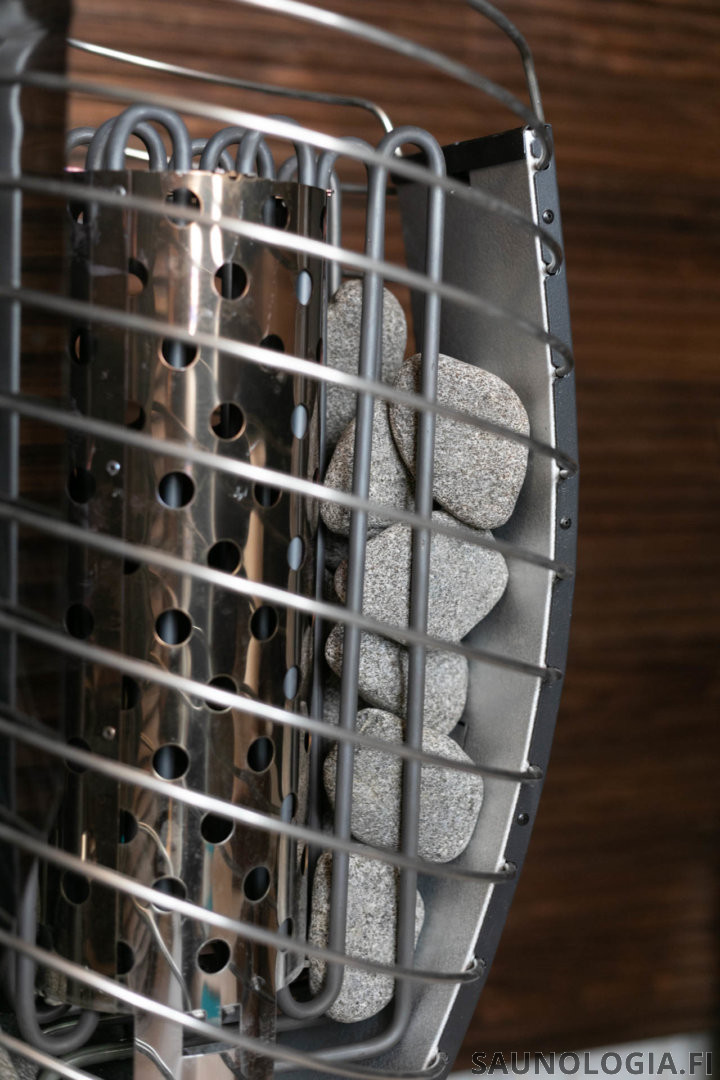
But Huum's frenzy of victory has had a flip side. In the r/sauna section of Reddit, a discussion forum popular among American sauna enthusiasts, there have been concerns about the durability of the product's resistors (the electric heating elements) and problems with warranty repairs. Without going too deep into the causes of the problems, it’s a real challenge to fit 9 kW of electrical resistors and a considerable number of heater stones into small space. If this is attempted, the package will be very tight and the stones will inevitably be subject to extreme heat. And if the stones don't stay intact, the resistors won't last long either.
Given this background, it was understandable that Harvia saw it as an engineering challenge to design a competitive product that was visibly elegant but also technically durable. Spirit's structure differs from its southern competitor in one essential respect. Where the core of the Huum Drop is crammed full of resistors and rocks, the Spirit's centre is left open. This is intended to enhance convection, but it also reduces stone volume and means that no resistors are located in the hottest part of the heater.
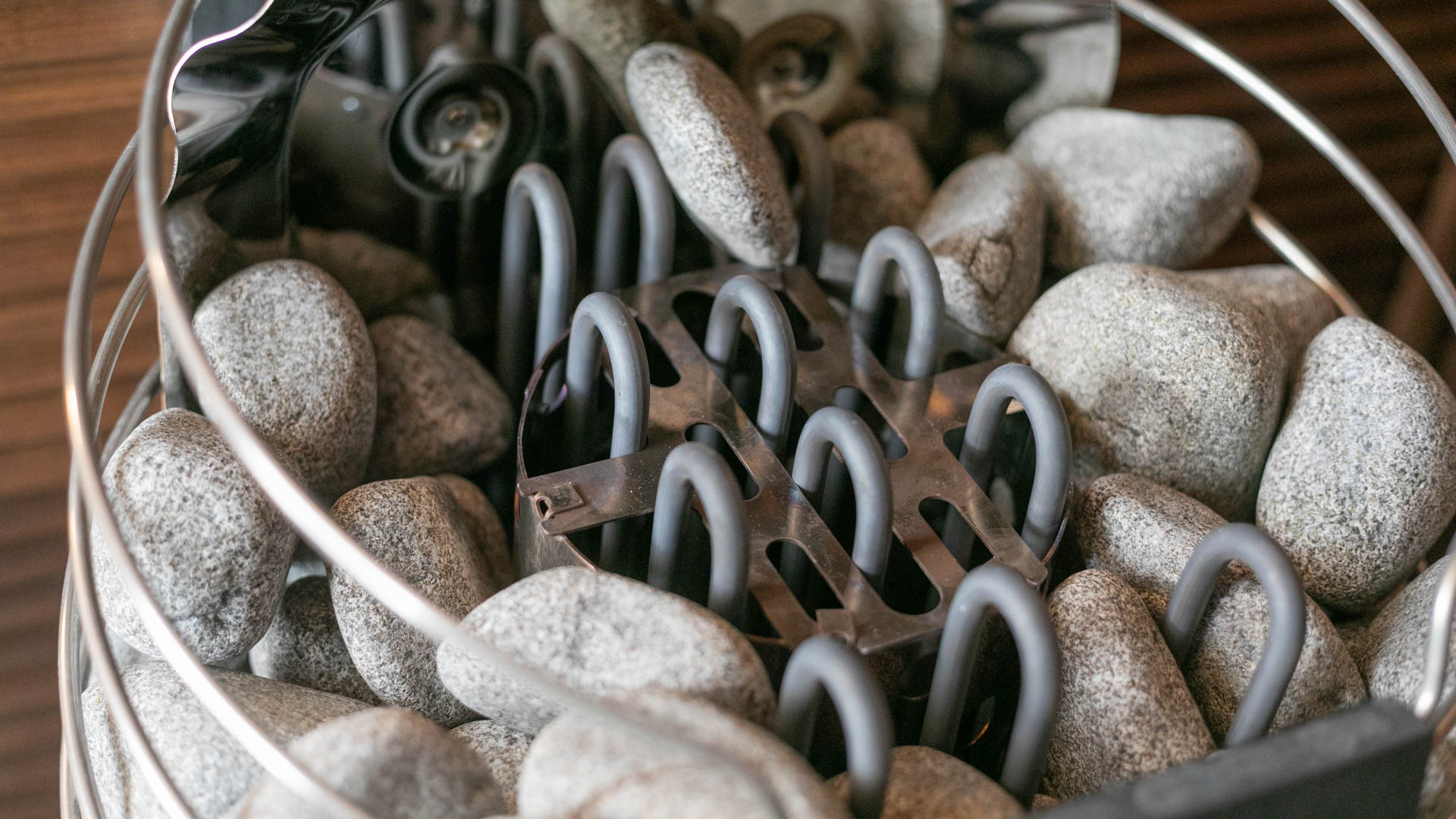
Caption: inside the Spirit, the stones are mostly not in contact with the resistors.
According to Arto Harvia, efficient manufacturing technology was also one of the design challenges for the heater. One of the ways this was achieved was by avoiding welding altogether in the assembly.
The Spirit heater is aimed at the international market. Spirit is available in several countries in May 2023, and will be available in the US, Canada and Asia by the end of the year. There are four product variants (6 and 9 kW, two control options) and a guard rail and an embedding flange are available options.
Experiences with Harvia Spirit: let the test begin!
The production version of the Spirit was evaluated by Saunologia in April 2023. In addition to the 9 kW heater, the test equipment included a new control centre, that is, power unit suitable for use inside the sauna room, and a Xenio Wifi control panel. In addition to the saunologist's (that's me referred to in third person...) household of four, two long-term sauna enthusiasts took part in the test.
The following test report starts with usability, which is assessed by ease of purchase, installation, instructions and use. This is followed by an assessment of technical performance, comfort of use and the heater’s performance in a test environment, and finally the price/quality ratio.
Usability: buying a heater
Although the heater came to Saunologia on loan from the manufacturer, I researched the options for purchasing a heater online. The heater is relatively simple to buy in Finland as it is sold as a single unit, despite the separate control panel and power unit. However, this is not clear from the product information and the customer must assume that this is the case. Contact the reseller if you have questions. Otherwise, as long as you remember to order the heater stones, it's simple.
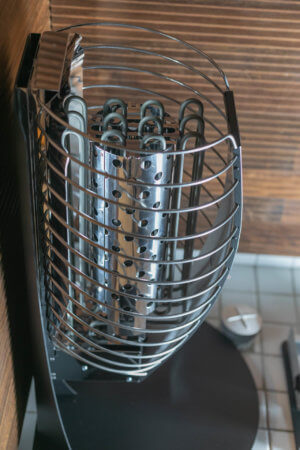
Usability: heater installation
The electric heater was installed in the Saunologia’s test sauna by the manufacturer. The work took a good couple of hours for the expert installer, so the you should be prepared for at least three hours of electrical work when installing such a system for the first time. Installing the heater stones was not included as part of the heater installation. Additionally, the control panel had to be connected to the wireless network.
Note: although the heater is usually wall mounted, it was here installed using a manufacturer's show room stand. This made little difference to its behavior as the installation height remained the same as if it were wall-mounted.
Stone installation, that is placing rounded olivine diabase stones into the heater was an interesting job. The net structure of the heater is very airy in design. According to the instructions, the largest stones are installed at the outer edge of the stone chamber. The stones must be large and well-spaced, otherwise they’ll happily fall onto the floor (or on the installer's toes).
It’s a good idea to buy at least 60kg (130 lbs) of rounded stones, as mentioned in the instructions, so that the right size stones are placed in the right places. The inside of the heater is narrow. Small oblong stones should be saved for the holes between the resistors and inserted vertically. It’s practically impossible to get stones through the hole in the back wall of the heater; I dropped a couple of small ones in as an experiment but gave up on that. I don't think I could ever get the stones out of there until they naturally break down without major disassemble work. So, better not to put them in.
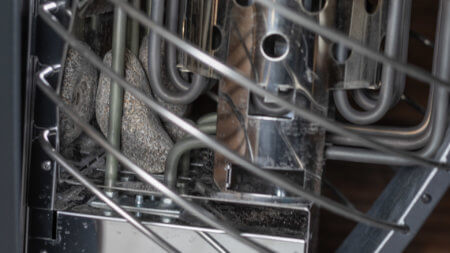
Caption: stones at the bottom of the heater's stone chamber, between the resistors. It’s very difficult to get the stones out of here before they have crumbled.
All in all, it took the experienced saunologist half an hour to install the stones, even when the stones were ready in an opened package and white gloves had been found. Read the instructions for replacing the stones in a separate article at. I managed to fit 58kg (127 lbs) of stones into the heater, so the manufacturer's statement was very accurate.
Usability: instructions for use
The instructions for use are divided into two parts. The electric heating appliance comes with a short multilingual printed instruction manual, with separate sections for each part of the appliance. There are around 8-12 languages included. The instructions for the heater, the control panel and the power unit are covered in three manuals. The global, brief approach is obviously aimed at saving paper, as the instructions for the control panel, for example, are partially shortened and the user is advised to download the longer PDF instructions from the web. Fortunately, the PDFs are linked to the printed materials via QR codes.
The practice is understandable, although it does seem a bit outdated or intermediate step as consumer electronics manuals are rapidly moving into the digital world. On the other hand, I personally appreciate printed instructions, which are more flexible to read – and more challenging to archive. The printed advice maybe most useful for electricians who need to access information about correct wiring.
The contents of the user manual for the heater do not offer any surprises. The instructions explain the principle of stone installation and the use of the heater clearly enough. Harvia's instructions for use include interesting instructions on the construction and ventilation of the sauna. Both are correct enough to be potentially useful, although they are probably not enough as anyone's building guide.
With the control panel, it becomes clear that the documentation does not fully reflect the operation of the control panel, as S-04 is missing from the additional settings and S-07 is redundant with the instructions. What this means is, well, hopefully, nothing to do with the sauna experience.
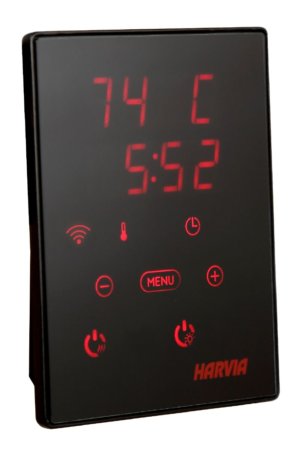
Usability: mobile app and remote access
The remote operation is activated by using both the mobile application and the physical control panel. A wireless network and its password are also required for the setup.
The instructions in the app are clear, the control panel is old-fashioned with a traditional LCD segment display and requires attention from a first timer. I've played with various IoT devices before and I found connecting the heater to the web via the Android app straightforward and took only a couple of minutes. I believe this is not a stumbling block for other users either. The physical control panel works okay, once you get accustomed to its behavioir.
The app will initially inform you that each heater comes with a free three-year subscription to the app. However, currently, Harvia does not have a subscription service, so for the time being, the remote user can breathe a sigh of relief.
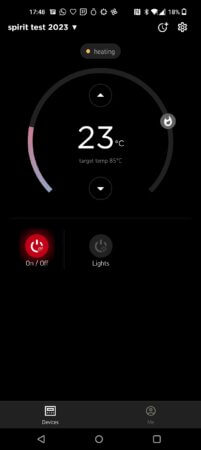
Caption: sample view of the My Harvia app ready to use. The app is clear and all main functionalities fit on a single view.
However, setting up remote access was not successful at first. The heater appeared in the app and the WiFi indicator on the control panel lit up, but the app said that remote control was not available, despite all the settings having been set up as instructed.
Or, so I thought at first. Namely, I had not yet set up remote operation of the device, which requires the control panel to be set to remote standby mode by pressing the power button for five seconds. This triggers a countdown, during which you must close the sauna door, if using the door switch as the safety device. Note that the door sensor will not be required for models sold outside EU.
When I did this, the next step in the remote control deployment was a non-functioning door switch. The magnetic door switch, used as the security mechanism, had jammed and only started working when it was replaced with a new one.
After that, it was smooth sailing. The app is simple and its main functions fit into one view. As expected, the app notifies you via a mobile phone notification (so-called push notification) when the heating starts and when the sauna is heated to the set temperature, even when the heating is started from the control panel.
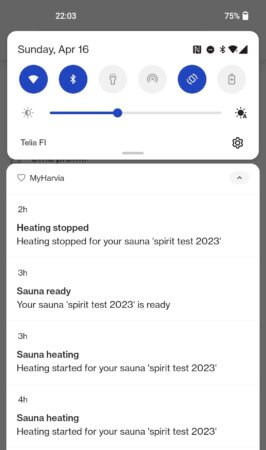
Caption: MyHarvia notifications in the Android notification area.
Technical operation of the heater
The sauna heater was tested in the indoor sauna at Saunologia's new headquarters, which has the size of 3.5 m², a volume of 7.4 m³ and an equivalent volume of about 11 m³ (118 cubic feet) when considering additional heat absorbing surfaces. The Harvia electric heater replaced the Estonian 9 kW heater (Saunum Primary) and was tested in the same way, keeping other differences to a minimum.
Earlier in the month, the test sauna had been heated a dozen times. The temperature of the sauna was measured using wireless RuuviTag measuring devices placed in the sauna at two fixed measuring points. A meter placed in the opposite corner of the electric heater, about 30 cm (1') from the ceiling, was used as the reference for the temperature in the sauna. In previous sauna sessions, the peak temperature at the beginning of the sauna session ranged between 61 and 70℃ (140 to 160 Fahrenheit degrees). I set a target of 65℃ for comparability.
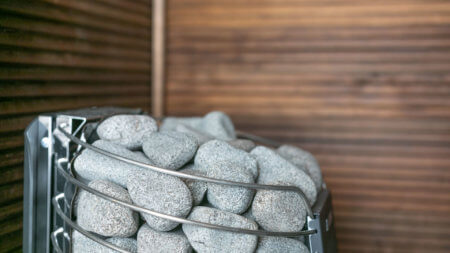
The test showed that the Spirit heated the sauna much faster, always in less than an hour, at best in 40 minutes. With the reference heater, sauna always took at least an hour to heat up, most often 1 hour 15 minutes, almost twice as long as with Spirit. It should be noted that the temperature depends entirely on the measuring point and, in the case of the Spirit, for example, the target temperature on the control panel must be set at 85℃ (185 F) to achieve a temperature of around 70℃.
The result must be taken with the caveat that outdoor temperatures during the test period rose from zero to around ten degrees Celsius, and the effect of mechanical ventilation on the displaced air temperature has not been taken into account (less cooling effect for indoor air). However, the ventilation level setting was constant, but the flow rate was not measured. On the other hand, in the experiment to increase the exhaust air exchange flow rate, no effect on the sauna warm-up time was observed which would have been expected if outdoor air significantly affected heating.
Surface temperatures of the heater and sauna room
I used a thermal imaging to examine the heating of the stove, the stones and the surfaces of the sauna room, as well as the air. This showed that the heater is running quite hot. The temperature of the surface stones was 200-300℃ at the end of heating, so it should easily provide löyly (or steam, I prefer talk about löyly). However, the sides of the heater do not heat up in the same way, which means that you need to aim the water directly at the top of the heater.
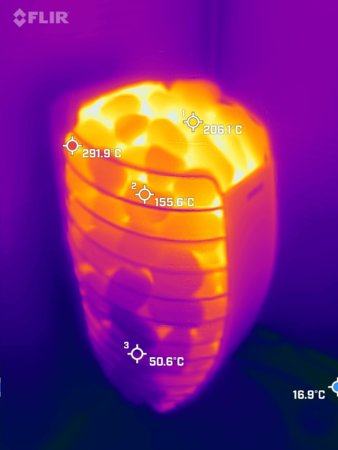
Caption: The surface temperature of the heater before the steam is thrown rises to well over 200 degrees Celsius, but the coolest parts of the sides of the stone chamber remain at almost room temperature.
Keeping the heater’s sides moderately warm is a double-edged sword. On the one hand, this gives many options for where to place the heater. On the other hand, you cannot get mild löyly from the sides of the heater. One member of the test group compared to his own wood-burning mesh heater in which he liked this particular option.
As expected by the heater's temperature distribution, the heater does not excessively heat the nearest surfaces. In the eyes of the thermal imaging camera, the walls have not heated up much more than the rest of the room, and the hottest point in the room directly above the heater is no more than 10 degrees hotter than the heater’s temperature sensor located further away in the ceiling.
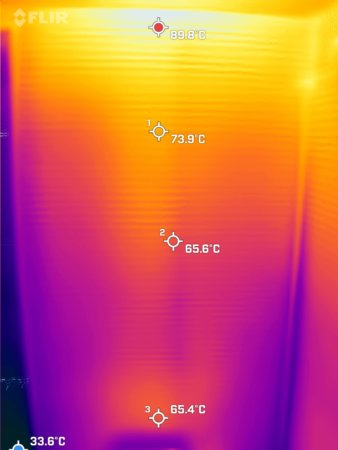
Energy consumption
It was not possible to meaningfully measure electricity consumption with Spirit. An approximation of a single session based on the house's total energy consumption is that during two hours, less than 10 kWh were spent.
As a subjective assessment, I would say that the consumption seems promising. This estimate is based primarily on the fast heating rate and secondarily on the fact that the heater is not constantly on during use. When the heater had reached the target temperature, it was only on for about a quarter of the time. Naturally, more energy was required when löyly was being thrown. The short heating time also improves energy efficiency because less heat escapes from the room.
These are, therefore, noticeable differences when comparing Spirit to the reference heater, which has a relatively high electricity consumption despite the fact that both have the same power rating. It has a long heating cycle and is mostly on during sauna bathing if the circulating air function is used. The consumption of the reference heater is also higher due to the larger amount of stones.
What kind of heat and löyly does Harvia Spirit provide?
The Saunologia test team gave Spirit a good overall rating, even though the heater was not a perfect match for my personal preferences. Let's examine why.
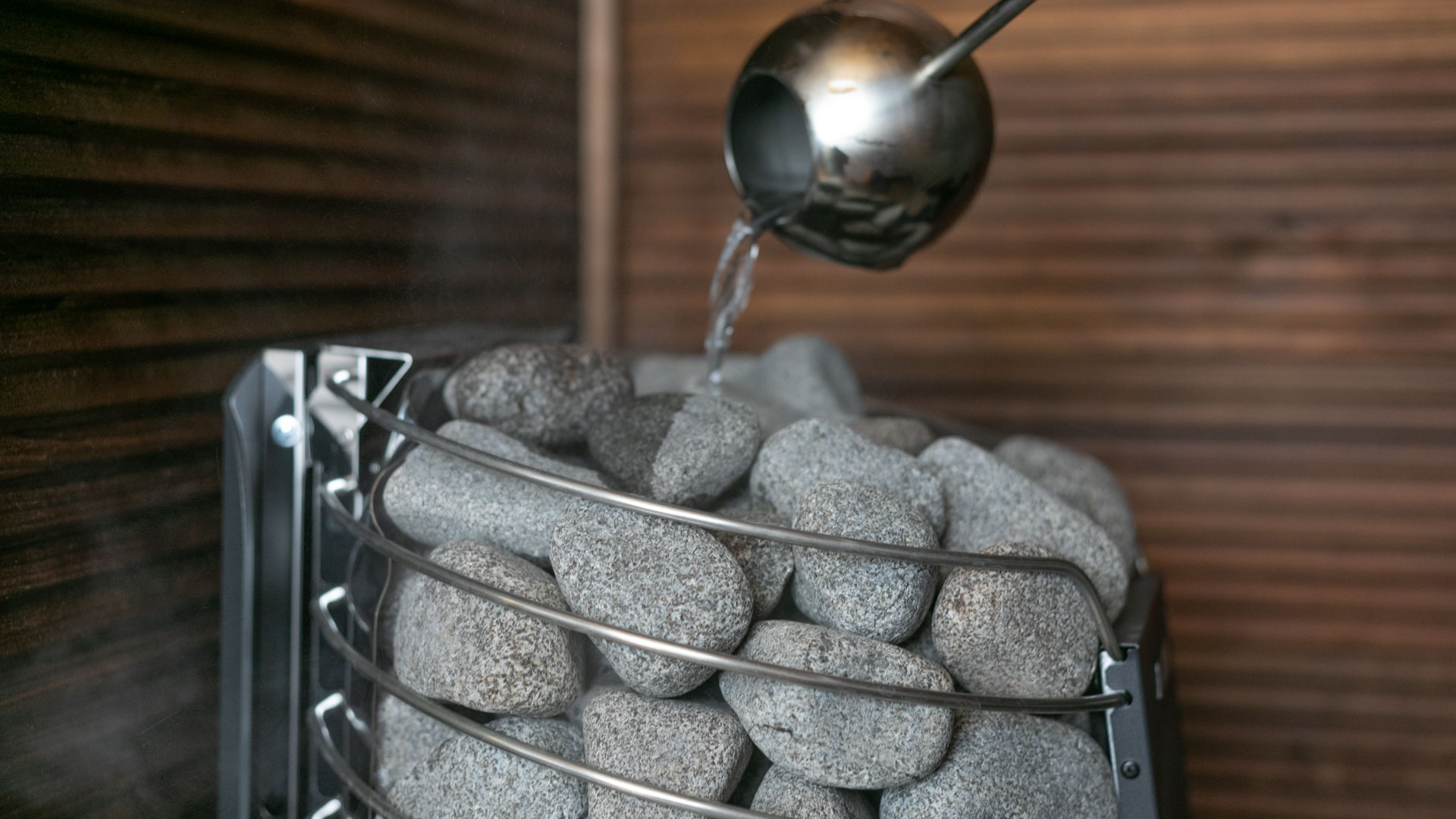
Note: The heater's heat is primarily influenced by the temperature and quantity of the heater stones, the temperature distribution in the sauna and the air circulation. In this test, I aimed for the sauna temperature to match the temperature of the previous reference heater as closely as possible as described earlier. In practice, differences in the positioning of the heater and the sensor meant that the target temperature of the Spirit was relatively lower than the reference heater (80 vs. 85℃). The actual temperature at the measuring point of the sauna was then 65-70℃.
The Saunologist’s personal sauna protocol includes starting the sauna without throwing steam. I usually lie on the benches meditatively until I start to sweat and then move on to the throwing of steam – creation of löyly.
My own experience is that the Spirit has a limited löyly capacity. The first few pours of water provide a strong löyly, but throwing more water later on generates only mild steam. The overall heating of the stones also depends on the power ratio between the sauna and the heater. In the reference sauna, the heater seemed to be overpowered in the sense that the stones could have been heated for a longer period of time where as the sauna reached its set temperature quicker, so the stones did not heat up as much.
But if you don't want to create excessive amounts of steam, you'll hardly notice this shortcoming. You can also compensate for this by raising the target temperature, a functionality for which this heater has been well-designed for.
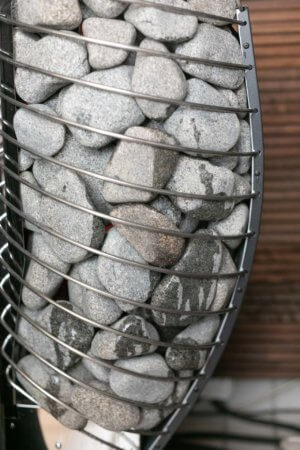
For me, the heater worked better than I expected, even if the löyly capacity was not quite the same as with the reference heater. Bigger shortcoming for me was that the sauna bathing time (time you voluntarily like to spend in sauna) seemed to be shorter than with the reference heater, which is probably due to the effects of air circulation and the different temperature distribution. This must be considered an advantage of the reference heater and not a particular downside of Spirit.
A test group of female sauna users in the household found the heater and the steam to be pleasantly gentle. They had the sauna temperature set about five degrees Celsius lower than during the other test runs. The sauna felt pleasantly evenly heated and the throws of steam, when self-administered, were suitable. In comparison, the absolute sauna air was 2/3 that used by the Saunologist (44 vs. 70 g/m3).
A peculiar observation about the Spirit is the peculiar "running sound". During heating, and especially after the active heating period, the heater clicks and clunks considerably. This is probably related to the life of the metal parts of the internal structure of the heater. The noise is not particularly loud, but it is noticeable in a quiet sauna.
Recommendations – for whom is Harvia Spirit a good heater?
Spirit is an efficient interior heater for a dry sauna. A couple of pictures should reveal how the design of the heater suits your taste. In terms of design, it is a great option for people who do not want a heater to dominate the sauna interior. Personally, though, I would have changed the front panel of the heater to stainless steel instead of black. The Spirit is therefore a good alternative to a conventional wall heater - albeit at a different price. I think the Spirit is an excellent challenger to the Huum Drop without the evident engineering challenges found in Drop.
Compared to floor and pillar heaters, the size of the Spirit is a strength. Like a corner heater, it can be placed in a very small space. In addition, its own height is reasonable, at a minimum 79 cm from the floor (31”).
| Good for | Things to improve |
|---|---|
| Energy efficiency
Design Fast warming up Technically impressive design Remote control Short safety distances |
Steam-throwing capacity for a löyly enthusiast
Usability of the control panel Installation of stones |
Price and quality
At the time of writing, the heater itself costs less than €600 in Finnish online shops, and the Xenio with Wifi control panel costs more than €700. An electric heater with all its parts can cost around a thousand euros if, in addition to the stones, you buy a safety railing (€140) or an embedding flange (€80). The 6 kW model is slightly cheaper than the 9 kW. The remote-controlled model cannot be considered expensive, as the prices of remote-controlled devices have been much higher in the past.
For my international readers, the quoted prices may seem unbelievably low, but they match the reality of the North European market well. Harvia does not yet disclose any suggested retail prices for new markets (Americas, Asia), but they aim at competitive pricing considering the value provided by the design.
Installing a decorative heater or, in fact, a whole electric heater system, will easily cost a couple of hundreds euros, depending on the location and the type of installation. As Saunologia’s series of articles on indoor sauna renovation revealed, the operation requires a lot of cabling and these can take hours to install, not to mention the actual electrical work.
Also note that the rounded stones are more expensive than conventional ones, e.g. 1,86 €/kg at Bauhaus (Finland), while the cheapest conventional sharp-edged 5-10cm stones cost only 0,34 €/kg. Rounded stones are therefore more than five times more expensive! The cost of a complete replacement of a single whole set of stones for Spirit is easily €90 at current prices, which is worth bearing in mind when considering the life cycle costs of the heater.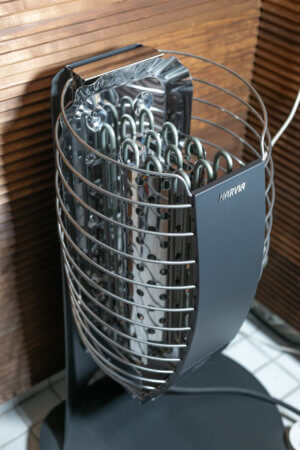
If the heater were to operate for 12 years and the stones were replaced six times, the cost of the stones would be the same as the original cost of the heater. For this type of heater, using small Kerkes ceramic stones in the spots closest to resistors could be a good investment, although the Harvia user manual still prohibits the use of ceramic stones.
In total, the purchase and installation of Spirit represents an investment of around a thousand euros. That's about twice the cost of the cheapest option, such as the Harvia Vega 8 kW with fixed control (similar to Kip model). A better benchmark, the Huum Drop heater with controls, always costs more than a thousand euros and thus becomes more expensive.
With the Spirit, you get value for money in many ways, so for the consumer who likes the design of the heater, the Spirit offers a good opportunity to create a great sauna experience. I would argue that the löyly potential is better than that offered by, for example, Harvia's other design heater Globe. Globe is clearly more expensive, more challenging to place because of its height, for example, and cannot hold quite as many stones. In comparison, Spirit is by the better choice in Harvia's range of design heaters.
Disclosure: This article was created in commercial collaboration with Harvia.
Big thanks to Päivi, Arto, Juho and Eeli in helping to create this content and Eloise for the bulk of translation based on the parallel Finnish article.
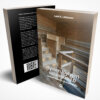

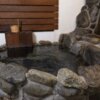


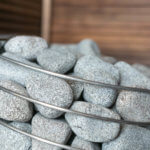
Thank you very much for this very useful article – just got mine yesterday! Question regarding stone installation. In the middle of the oven within the “secret weapon”-cylinder you do not place stones between the resistors, right?
Stones are only placed between the resistors around this cylinder? There the manual isn’t clear enough for me – as you mentioned “insert stones vertically between resistors”, but not within the cylinder, only in front and in the back of the cylinder?
Hi Dave,

Yes, only outside the cylinder, but some of the stones also go between heating elements. This is visible in this photo
Hello, is the temperature probe mounted externally (on the ceiling or wall), or internal to the heater (like the Cilindro)?
Thanks!
The tested model has an external temperature sensor. This does not guarantee that the North American version will thou, have to wait until the final specs are out.
Excellent valuable article as usual Lassi!
I wonder if a smarter heater couldn’t be made? Something other than static on/off 6k or 9k or whatever k.
It should be possible for the heater controller to know about how hot the stones are. So instead of waiting until the thermostat calls for it turning on all elements full power to raise the sauna temp, could it turn on only one heating element, perhaps the center element on a Spirit, to heat the stones when needed but without overheating the sauna? Or turn on all of the elements at 50%?
Thank you!
Some heaters allow you to determine a stone target temperature, which might be useful if the stones warm up uniformly. Harvia has also utilized a variation of this.
I have not seen any models that would have anything but 3/3 phases running on/off. You should have a specific array of elements for that.